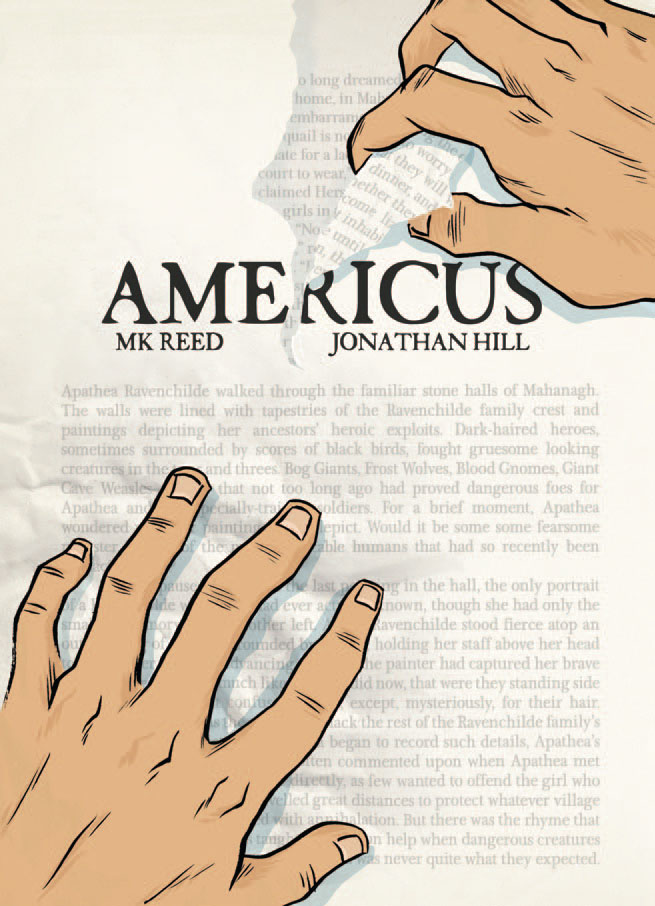
M. K. Reed, art by Jonathan Hill
First Second/Roaring Brook Press
216 pages
As the shortest kid in his class in Americus, Okla., Neil Barton has always been bullied, even at eighth-grade graduation. Will high school be any different?
Ahead of Neil on the public library’s waiting list for the eighth installment of their favorite fantasy series, his best friend Danny Burns starts summer vacation buried in The Chronicles of Apathea Ravenchilde, the Huntress Witch – until his mother confiscates it. Calling its witches the “Devil’s servants,” she drags Danny and the book back to the library. Confronting the young “temptress” librarian, Charlotte Murphy, Mrs. Burns rips the book apart.
Clutching its remains, Charlotte protests that 38 people are on a waiting list for this award-winning graphic novel. Mrs. Burns dismisses Charlotte’s mention of “the separation of church and state” as “godless leftie hogwash” and says the series should be banned. At dinnertime, Danny’s mother claims to be protecting him from liberals, atheists, and gays. “I’m gay!” yells Danny. A few days later, Danny is banished to military school in Ohio.
As Neil awaits the library’s replacement copy, Charlotte says she can’t wait to discuss the new Apathea installment with him. Hiring Neil as a library page, she dubs him “defender of our ideals and honor, guardian of the bookshelves” – with a ruler instead of a sword.
Bowing, Neil responds, “I humbly accept this post, my liege, and will defend thy domain with my last drop of blood.” He is soon to be tested by the book banners.
Organized by Mrs. Burns, the Keep Faith in Christ Literary Awareness and Library Advocacy Group petitions the Library Board to remove the Apathea books because their promotion of “occult and satanic witchcraft” is obscene and “harmful to children.”
As Americus Public Library’s youth services librarian who has read all eight volumes, Charlotte testifies that they are “less obscene than most PG movies.” The Board President assigns its members to read one book in the series to judge the grounds for removal.
Meanwhile, Neil survives his first days of high school. His cool new shirt helps him avoid bullies until shop class, when older guys hold him close to the power saw. Later, when awkward Jael is teased about her handmade dress, Neil recognizes its design from a book. As they discover their mutual love for the Apathea series, little hearts appear in the air.
When the Library Board reconvenes, only two of its five members have read the whole book – the president and a woman who enjoyed the entire series with her daughters. Members of the public weigh in: A father whose sons had never shown interest in reading says the books captivated his whole family. A librarian from another Oklahoma library handling an Apathea complaint sees the books transforming many young people into avid readers. A girl who noticed a classmate being bullied realized that Apathea wouldn’t stand for that – so she confronted the mean girls herself.
Neil testifies that he loves the series because when Apathea gives the bad guys what they deserve—“I feel like the impossible becomes possible. Like it’s in me to take down monsters, too.”
Charlotte presents a petition to keep the books, signed by 350 library patrons. But Mrs. Burns seeks the last word: “There are more important things in life than your freedom and choices.”
Charlotte interrupts: “Our freedoms allow you to practice your religion and say your piece here tonight, but you don’t speak for everyone.” The Board votes: three for retaining the book, two against. Apathea remains in the library.
Having survived the defense of his beloved books as well as his freshman year of high school, Neil stands up to the school bullies, enjoys his new friends at school and the library, and lets his mother see that he’s happy.
In his first graphic novel, cartoonist Jonathan Hill captures characters and settings in meticulous black-and-white detail. Sweeping school scenes reward examination – a sea of auditorium seats, rows of desks, crowded hallways. Commanding the top third of a page, a large audience awaits the graduation ceremony, 20 individuals share seven conversation balloons, receding to small print in back rows. Supermarket crowds discuss the book banning. A page without conversation follows Neil through a school day’s changing backdrops.
All nine chapters include two-to-three-page inserts with glimpses into Apathea’s story. Scenes such as a swarm of ravens who squawk “Aunts!” at the magic young warrior woman are rendered in a classic style, black and gray with dramatic white shapes that contrast with the lighter line drawings of modern Americus, forming a graphic novel within a graphic novel.
Comics writer M. K. Reed’s dramatization of a book-banning attempt engages readers in real-life controversial issues faced in many communities today. Although the fictitious censors’ objections seem outlandish, at least 326 challenges to books occurred in U.S. schools and libraries in 2011, according to the American Library Association, which estimates that 70 to 80 percent of attempts to ban books are unreported. This story’s caricature is only slightly exaggerated.
Portraying teenagers’ social hierarchies with a sure touch, Reed illuminates relationships between youth, parents, and caring (or not-so-caring) adults, such as teachers and librarians. She contrasts parents who use banning as a means of control with parents who build mutual respect with their children. Even outsiders such as Neil and Danny find places to belong.
Both realistic and fantastical transformations in this book can hook adults and youth.
In the popular graphic novel format, Americus is a good bet for building young people’s awareness of their right to read. Banned Books Week is Sept. 30 to Oct. 6, 2012; see www.bannedbooksweek.org.
Contact: (888) 330-8477, www.firstsecondbooks.com.
Cathi Dunn MacRae, former editor of Voice of Youth Advocates (VOYA), specializes in teen writing and reading.





























